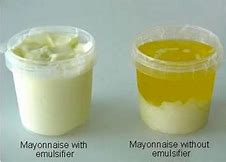How emulsifiers improve stability in food products
The Important Advantages of Emulsifiers for Smooth and Stable Mixtures
Emulsifiers are important in creating steady and smooth combinations throughout different industries. They lower surface tension in between immiscible liquids, causing improved structure and general sensory experiences. In food and cosmetics, their role expands past simple blending; they likewise improve service life and product honesty. Recognizing the kinds and applications of emulsifiers discloses their significance in formulation processes. However, the nuances of their efficiency warrant further expedition.
Comprehending Emulsifiers: The Science Behind the Blend
Although emulsifiers are frequently forgotten in daily cooking and food production, they play an important duty in stabilizing blends that would or else separate. Emulsifiers are substances that reduce surface tension in between 2 immiscible liquids, such as oil and water. They possess both hydrophilic (water-attracting) and hydrophobic (water-repelling) residential or commercial properties, enabling them to connect with both stages. This unique particular makes it possible for emulsifiers to form a stable interface, protecting against the splitting up of fats and liquids.
Typical instances of emulsifiers consist of lecithin, often acquired from eggs or soybeans, and mono- and diglycerides. These substances create an uniform texture in products like mayo, salad dressings, and sauces. The scientific research behind emulsifiers hinges on their ability to create a secure emulsion, which is vital for achieving desirable food top quality and life span. Recognizing the function of emulsifiers is crucial for food scientists and culinary experts going for consistent outcomes.
Culinary Applications: Enhancing Taste and Structure
Emulsifiers greatly boost culinary applications by enhancing both taste and appearance in a variety of food (emulsifiers). They play an important function in developing secure emulsions, which are vital for sauces, dressings, and mayonnaise. By allowing the even circulation of fats and water, emulsifiers ensure that flavors are well-blended and unified, boosting the overall preference experience
In baked items, emulsifiers add to a finer crumb structure and enhanced dampness retention, leading to products that are attractive and soft. In addition, they assist expand rack life by stopping splitting up and maintaining freshness.
In milk products, emulsifiers aid in producing smooth structures, vital for products like gelato and cream cheese, where mouthfeel significantly influences customer enjoyment. Overall, the use of emulsifiers in culinary applications not just raises flavor accounts however also improves the sensory experience of various food things, making them a lot more appealing and satisfying.

Aesthetic Uses: Developing Lavish Formulas
When developing aesthetic items, the incorporation of emulsifiers is necessary for attaining extravagant and smooth appearances. These representatives facilitate the mixing of water and oil stages, creating steady solutions that enhance product efficiency and individual experience. Emulsifiers not only improve the consistency of lotions and lotions but also add to the general sensory features, permitting a more enjoyable application and feel on the skin.
Furthermore, emulsifiers play an important duty in the efficient shipment of energetic ingredients, making certain that they continue to be uniformly dispersed throughout the formulation. This consistent circulation improves the item's efficiency, supplying targeted advantages such as hydration, anti-aging, and defense. The right emulsifier can give a preferred thickness, protecting against separation and maintaining product stability over time. Eventually, emulsifiers are integral in creating top quality cosmetic formulations that satisfy consumer expectations for deluxe and effectiveness.
Types of Emulsifiers: Natural vs. Artificial
Comprehending the differences between synthetic and natural emulsifiers is necessary for formulators intending to enhance aesthetic items. All-natural emulsifiers, stemmed from plant or animal resources, include ingredients like lecithin, beeswax, and different gums. They are usually preferred for their skin-friendly buildings and biodegradability. Furthermore, they can improve the sensory profile of solutions, providing an extra enticing appearance and really feel.
On the other hand, synthetic emulsifiers are chemically engineered to create specific functionalities and security. Common examples include polysorbates and stearic acid. These emulsifiers commonly supply remarkable efficiency regarding emulsification effectiveness and shelf-life security. Nonetheless, they might raise concerns regarding skin level of sensitivity and ecological effect.
Ultimately, the selection between synthetic and all-natural emulsifiers relies on the preferred product features, formulation objectives, and customer preferences, highlighting the importance of recognizing their distinct homes. emulsifiers.
The Function of Emulsifiers in Food Conservation

Tips for Utilizing Emulsifiers Effectively in Dishes and Products
When utilizing emulsifiers in items and dishes, choosing the suitable kind is essential for achieving desired outcomes. Additionally, utilizing proper mixing techniques can significantly improve the stability of emulsified mixtures. Ultimately, understanding storage methods and rack life guarantees the long life and efficiency of these emulsifiers.
Picking the Right Emulsifier

Selecting the appropriate emulsifier can significantly improve the structure and security of a mixture, as the ideal selection relies on the details components and desired outcome. Different variables affect this decision, including the type of oils or fats, the presence of water, and the target uniformity. Lecithin is excellent for sauces and dressings, while xanthan periodontal functions well Web Site in gluten-free baking. Furthermore, the emulsifier's compatibility recommended you read with various other components plays a substantial duty in attaining the wanted stability. It is vital to think about the temperature level variety of the application, as some emulsifiers perform better under details problems. Ultimately, understanding the qualities of each emulsifier will bring about much more reliable formula in recipes and products.
Correct Mixing Strategies
Utilizing reliable blending techniques is necessary for achieving optimal emulsification in recipes and products. It is essential to introduce emulsifiers progressively, permitting them to spread evenly throughout the mixture. High-shear blending techniques, such as using a blender or food processor or an immersion mixer, can enhance emulsifier efficiency by damaging down fat globules. Maintaining a regular temperature throughout blending also aids in achieving a stable emulsion, as liquids and fats can mix much more effectively when heated. In addition, including active ingredients in the proper order-- starting with the liquid phase adhered to by the fat stage-- ensures also distribution. Mixing should proceed until the desired uniformity is gotten to, preventing over-mixing, which can lead to splitting up. Appropriate strategies ultimately cause smoother, extra secure emulsions.
Storage Space and Shelf Life
The efficiency of emulsifiers can substantially boost the quality of blends, proper storage and focus to shelf life are vital for maintaining their efficiency. Emulsifiers ought to be saved in an amazing, completely dry environment, far from direct sunshine and moisture, which can see this here degrade their residential properties. It is advisable to keep them in impermeable containers to protect against contamination and oxidation. Additionally, inspecting the expiry days and adhering to recommended storage space standards can optimize their effectiveness. Routine evaluations of structure and stability in combinations can suggest whether the emulsifier is still working successfully. By adhering to these storage space techniques, individuals can assure that their emulsifiers continue to be powerful, resulting in consistently smooth and stable blends in products and dishes.
Often Asked Questions
Are Emulsifiers Safe for Individuals With Dietary Restrictions?
Emulsifiers can be safe for people with dietary restrictions, depending on their resource and composition. It's vital for those with allergic reactions or certain nutritional demands to carefully assess active ingredient tags and speak with health care experts.
Just How Do Emulsifiers Influence the Service Life of Products?
Emulsifiers improve the shelf life of products by stabilizing mixes, preventing splitting up, and lowering spoilage. Their capacity to maintain harmony helps assure longevity, ultimately maintaining flavor, texture, and overall high quality in various food things.
Can I Make Emulsifiers at Home?
Yes, home made emulsifiers can be produced using all-natural components like egg yolks, mustard, or honey. These choices can help mix oil and water, but results might vary based on the particular recipe and technique used.
What Prevail Emulsifier Allergies to Expect?
Common emulsifier allergic reactions consist of responses to soy lecithin, egg yolk, and dairy-based emulsifiers. Individuals with level of sensitivities may experience signs and symptoms like hives, gastrointestinal distress, or breathing problems upon exposure to these components in different food items.
Exactly How Do Emulsifiers Influence Nutritional Worth?
Emulsifiers can influence dietary worth by improving nutrient absorption and bioavailability - emulsifiers. Nonetheless, too much use could cause nutrition loss or imbalance, potentially influencing health outcomes, particularly in processed foods where they are common
Emulsifiers greatly boost culinary applications by enhancing both flavor and structure in a range of food items. In milk products, emulsifiers aid in producing smooth appearances, vital for items like ice lotion and lotion cheese, where mouthfeel greatly affects consumer pleasure. In the domain of food preservation, emulsifiers play a considerable duty in keeping the quality and shelf-life of various products. In items like salad dressings and sauces, emulsifiers aid to keep appearance and taste stability over time, guaranteeing that the food remains appealing to consumers. Common emulsifier allergic reactions include responses to soy lecithin, egg yolk, and dairy-based emulsifiers.